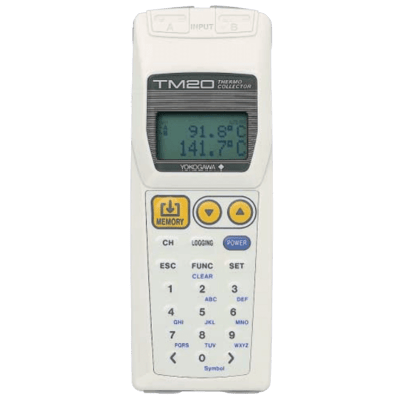TM20 Digital Thermometer
Brand: Yokogawa Electric CorporationThe TM20 offers excellent data management functions:
- Collect up to 5000 data items with time-stamp, tag name and inspector name.
- Save 2 weeks continuous data logging with 1 minute interval (up to 20000 data items, measuring interval is 1sec. to 24 hours.).
- Information on when, by whom and what is measured is saved along with the data.
- Memory Key
- Each press of this key saves the measured data, along with 3 other monitoring items: the name of the object being measured, operator’s name, and date and time of measurement.
- Selection of Registered Tag Name
- Select from the list of up to 50 registered tag names (objects to be measured).
- Input Selection Key
- Collector/Logging Mode Selector Key
- Switches between the collector mode (saves measured data when necessary) and logging mode (saves measured data continuously).
- When used in the collector mode only, saves up to 5000 data items.
- When used in the logging mode only, saves up to 20000 data items.
- Measuring interval: 1 second to 24 hours (Under simultaneous 2-channel measurement with the TM20, 2 seconds is the minimum.)
- Start-of-measurement time: timer can be set.
- User-friendly FUNC Key
- You can select setup items in the same way as you choose options from the built-in menu of a cellular phone.
- Selection of Operator Name
- With the (1) key, you can recall a list of up to 10 operator names and can also change any of these names.
- Record-keeping On Measurement Failure Handling
- By pre-registering a list of up to 32 comments on how to handle particular measurement failures, you can keep records of how the measurement failure was dealt with by selecting the desired comment from the list using the (4) key. (The TM10 supports this feature with TM10 Version 1.10 when used with application software version 1.30 or later.)
- Setup Keys
- Register tag names, set alarm points, and define measuring conditions, such as the measuring interval for the logging mode. These setting tasks can also be carried out from a PC.
- Digital Input Terminal
- For connecting to an optional non-contact probe.
- RS-232C I/O Terminals
- Used to exchange data with a PC or send data to a dedicated printer.
Specifications
Accuracy
- ± (0.1 % of Reading + 0.2 % of Range) - Voltage Input
- ± (1 % of Reading + 1° C) or ± 3° C (5.4° F), Depending on the Accuracy of the Non-Contact Probe - Thermal Emssion
- ± [0.1 % of Reading + 0.7° C (1.26° F)] - for Thermocouple -200° to 100.1° C (-328° to 212.18° F)
- ± [0.1 % of Reading + 1.0° C (1.8° F)] - for Thermocouple -100.0° C (-148° F) or Above
- ± 0.4° C (± 0.72° F) - when the Temperature of the Input Terminal is in Equilibrium
- ± 3 % Relative Humidity - for 20 to 80 % Relative Humidity
- ± 4 % Relative Humidity - for 0 to 20 % Relative Humidity, 80 to 90 % Relative Humidity
Alarm
- Upper & Lower Limit Alarms
Applications
- Perishable Food & Fr oz.en Food Products Quality Control
- Product Temperature Measurement Test
- Temperature Checks in Equipment Maintenance
- Temperature Management in Production Processes, Refrigerated Warehouse, Research & Development
Approvals & Certifications
- CE
- EMC Standards EMI (Interference Signal): EN 55011, 1998, EN 61326-1, 1998+A1 (Class B, Group 1)
- EMC Standards EMS (Immunity): EN 50082-1,1997, EN 61326,1998+A1
Battery Life
- 1 Month Approximately when Operated in Logging Mode at 1-Minute Intervals
- 1.5 Months Approximately when Operated in Logging Mode at 10-Minute Intervals
- 5 Days Approximately when Operated in Collector Mode 8 Hours A Day Including 30 minutes of Communication
Channels
- 1-Channel - when D Channel is used with the Non-Contact Probe
- 2-Channels - when A & B Channels are used for Thermocouple or Voltage Input
Communication
- EIA RS-232C Standard
CPU Type
- i486DX or Higher
Display
- LCD Display with Backlight
Environmental Protection
- IP54 (Dust-Proof & Drip-Proof Requirements of IEC 529)
Function
- Auto Power Off
- Battery Alarm
- Chime
- Clock Display
- Computing
- Correction
- Function Lock
- Scaling
Humidity
- 20 to 80 % Relative Humidity, Non-Condensing
Input
- ± 1 V
- ± 100 mV
Measuring Time
- 0.5 seconds or Longer when 1-Channel is used - Collector Mode
- 1 second or Longer when 2-Channels are used - Collector Mode
- 1 second to 24 Hours when 1-Channel is used - Logging Mode
- 2 seconds to 24 Hours when 2-Channels are used - Logging Mode
Operating Temperature
- 0° to 50° C (32° to 122° F)
Output
- 1 mV/ % Relative Humidity
- 1 mV/°C - Temperature
Power Requirement
- Two AA Alkaline Dry Batteries (LR6)
Resolution
- 0.001 V - Voltage Input
- 0.1 mV - Voltage Input
- 0.1° C - Thermocouple
- 1° C - Thermal Emission
Response Time
- 15 seconds - Temperature & Humidity Probe
Sensor, Probe Material
- 316 Stainless Steel - SUS 316
Sensor, Probe Type
- E Thermocouple
- J Thermocouple
- K Thermocouple
- T Thermocouple
System Requirements
- Microsoft Excel 95/97 Software
- Windows® 95/Windows® 98/Windows® NT 4.0 Operating Systems
Temperature Range
- -20° to 400° C (-4° to 752° F) - Thermal Emission
- -200° to 1,000° C (-328° to 1,832° F) - Typical J Thermocouple Probe
- -200° to 1,372° C (-328° to 2,501.6° F) - Typical K Thermocouple Probe
- -200° to 400° C (-328° to 752° F) - Typical T Thermocouple Probe
- -200° to 700° C (-328° to 1,292° F) - Typical E Thermocouple Probe
- Perishable Food & Frozen Food Products Quality Control
- Product Temperature Measurement Test
- Temperature Checks in Equipment Maintenance
- Temperature Management in Production Processes, Refrigerated Warehouse, Research & Development

